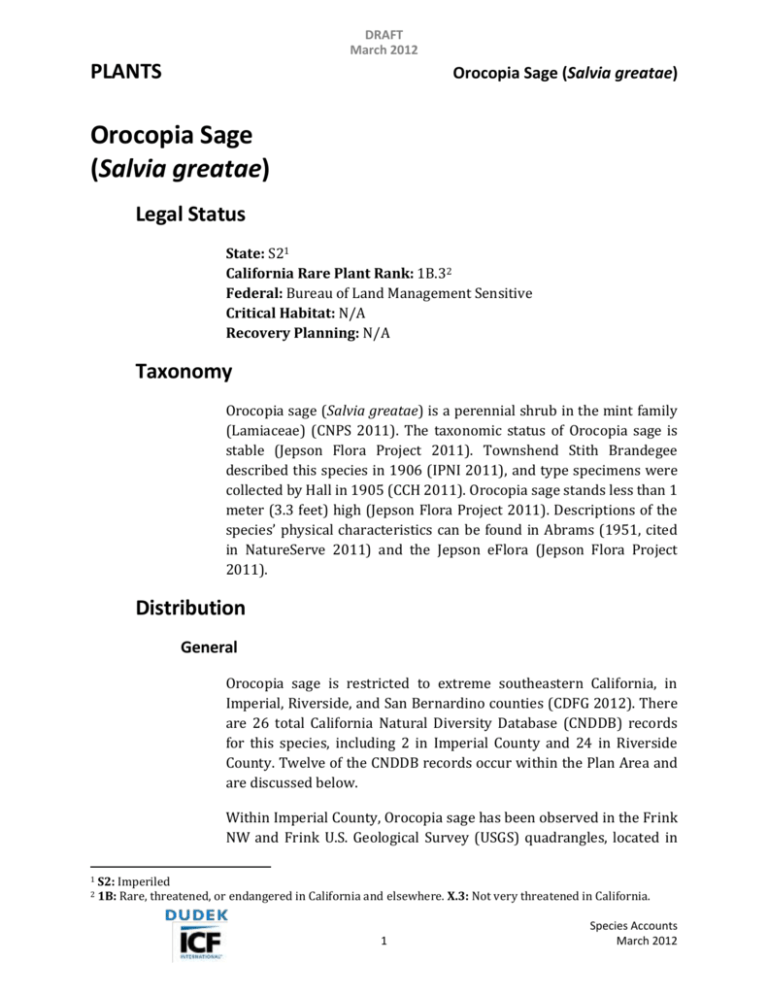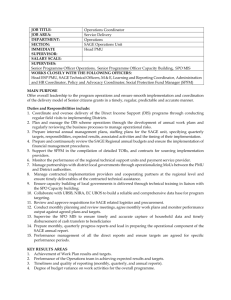Orocopia_sage
advertisement

DRAFT March 2012 PLANTS Orocopia Sage (Salvia greatae) Orocopia Sage (Salvia greatae) Legal Status State: S21 California Rare Plant Rank: 1B.32 Federal: Bureau of Land Management Sensitive Critical Habitat: N/A Recovery Planning: N/A Taxonomy Orocopia sage (Salvia greatae) is a perennial shrub in the mint family (Lamiaceae) (CNPS 2011). The taxonomic status of Orocopia sage is stable (Jepson Flora Project 2011). Townshend Stith Brandegee described this species in 1906 (IPNI 2011), and type specimens were collected by Hall in 1905 (CCH 2011). Orocopia sage stands less than 1 meter (3.3 feet) high (Jepson Flora Project 2011). Descriptions of the species’ physical characteristics can be found in Abrams (1951, cited in NatureServe 2011) and the Jepson eFlora (Jepson Flora Project 2011). Distribution General Orocopia sage is restricted to extreme southeastern California, in Imperial, Riverside, and San Bernardino counties (CDFG 2012). There are 26 total California Natural Diversity Database (CNDDB) records for this species, including 2 in Imperial County and 24 in Riverside County. Twelve of the CNDDB records occur within the Plan Area and are discussed below. Within Imperial County, Orocopia sage has been observed in the Frink NW and Frink U.S. Geological Survey (USGS) quadrangles, located in 1 2 S2: Imperiled 1B: Rare, threatened, or endangered in California and elsewhere. X.3: Not very threatened in California. 1 Species Accounts March 2012 DRAFT March 2012 PLANTS Orocopia Sage (Salvia greatae) the far northwestern corner of the county. The vast majority of the occurrences are located in south central Riverside County, in the following quadrangles: Corn Spring, Durmid, Frink NW, Mortmar, Orocopia Canyon, and Red Canyon (CDFG 2012). The species has also been reported in the Desert Center quadrangle (CNPS 2011). Figure SP-P19 shows the species’ range in California. Distribution and Occurrences within the Plan Area Historical Of the 12 CNDDB records for Orocopia sage within the Plan Area, 3 were originally added prior to 1990, and all of these sites have not been seen after 1990. All of the sites are at least partially within public lands, although one site is at least partially on private property in addition to Bureau of Land Management (BLM) land and the Salton Sea State Recreation Area run by the California Department of Parks and Recreation. Another site is administered by the BLM. One record is wholly within the Department of Defense’s Chocolate Mountains Aerial Gunnery Range (AGR) (CDFG 2012). Recent Nine CNDDB records within the Plan Area have been added after 1990, and all of these records are within the Chocolate Mountains AGR (CDFG 2012). In addition, there are two California Consortium of Herbaria (CCH) records from 2003, apparently on BLM lands, and one from 2004, all in the Chocolate Mountains; the remaining 45 CCH records for this species are historic (CCH 2012). Figure SP-P19 shows the species model for Orocopia sage, with both historical and recent occurrences overlaid (CDFG 2012). Natural History Habitat Requirements Orocopia sage occurs in Sonoran desert scrub within broad alluvial bajadas and fans adjacent to desert washes and in desert dry wash woodlands (CDFG 2012; CVAG 2007). Edaphic requirements are 2 Species Accounts March 2012 DRAFT March 2012 PLANTS Orocopia Sage (Salvia greatae) gravelly or rocky soil, or rocky slopes of canyons (CDFG 2012). Many of the CNDDB records report plants growing in canyons or washes on alluvial soils. The species does not appear to occur within the immediate wash zone (CVAG 2007). This species has been observed at elevations of -40 to 825 meters (131 to 2,707 feet) (CNPS 2011; CDFG 2012; Jepson Flora Project 2011), with the lowest elevations documented from Imperial County near the Salton Sea and the highest elevations recorded from the Orocopia, Chocolate, and Chuckwalla mountain ranges. The Coachella Valley Multiple Species Habitat Conservation Plan (CV MSHCP) cites elevations of up to “2,800 feet in the Orocopia Mountains” (CVAG 2007). Associated species appear to be cheesebush (Ambrosia [Hymenoclea] salsola), sweetbush (Bebbia juncea), indigo-bush (Psorothamnus schottii), brittlebush (Encelia farinosa), and creosote bush (Larrea tridentata). A number of records note that very little white bur-sage (Ambrosia dumosa) appears alongside Orocopia sage individuals (CDFG 2012). North, west, and southwest aspects are noted for sites where Orocopia sage has been documented as well as on the southfacing slopes of the Orocopia Mountains (CDFG 2012; CVAG 2007). Table 1. Habitat Associations for Orocopia Sage Land Cover Type Sonoran desert scrub Habitat Designation Primary habitat Habitat Parameters Alluvial fans adjacent to desert washes, 131 to 2,800 feet elevation Supporting Information CDFG 2012; CVAG 2007 Reproduction Little is known of the life history and ecology of Orocopia sage (CVAG 2007). Pollination of Orocopia sage appears to be carried out by bees or butterflies, or a combination of both (Wester and Claßen-Bockhoff 2011). Flowering of this perennial evergreen shrub occurs from March to April (CNPS 2011; Jepson Flora Project 2011). Nutlets are brown to gray, flat, and approximately 2 to 3 millimeters (0.08 to 0.1 inch) wide (Jepson Flora Project 2011). 3 Species Accounts March 2012 DRAFT March 2012 PLANTS Orocopia Sage (Salvia greatae) Ecological Relationships Little is known about the species’ ecological relationships. As mentioned previously, it appears to depend on bees and/or butterflies for pollination, but this assumption is based on flower morphology rather than empirical observation; exact pollinator species identities are unknown (Wester and Claßen-Bockhoff 2011). Population Status and Trends Global: G2, Imperiled (CDFG 2012b) State: S2, Imperiled (CDFG 2012b) Orocopia sage is classified as a 1B.3 rare plant species by the California Rare Plant Rank (CRPR) system. Species with the 1B rank are rare, threatened, or endangered in California and elsewhere. The 0.3 threat rank indicates that this species is not very endangered (<20% of occurrences threatened, or a low degree and immediacy of threat or no current threats known) in California. Orocopia sage is typically one of the dominant members of the vegetation where it occurs (CVAG 2007). However, population sizes and densities are poorly understood. The CV MSHCP cites populations of 50 to 1,000 individuals during surveys conducted by K. Barrows in 1986 (CVAG 2007). University of California, Riverside, (UCR) Herbarium botanists conducted reconnaissance surveys of known Orocopia sage populations in 2002, but results indicated the need for additional surveys. Of the 15 occurrences visited at that time, the UCR botanists could not locate two populations, two new populations were located, and four populations appeared to be much larger than previously described (Allen 2003, cited in CVAG 2007). In addition, unknown and isolated populations of Orocopia sage could be at risk. Threats and Environmental Stressors Threats to Orocopia sage are minimal because most of the known occurrences of this species are within protected public lands, including the Mecca Hills, Orocopia Mountains, and Chuckwalla Mountains Wilderness Areas, established by the 1994 Desert Protection Act (CVAG 2007). In addition, most occurrences are on 4 Species Accounts March 2012 DRAFT March 2012 PLANTS Orocopia Sage (Salvia greatae) rocky slopes or alluvial fans that are either some distance from major roads or inaccessible to off-highway vehicle (OHV) traffic (CVAG 2007; CDFG 2012). A number of CNDDB occurrences are located within the boundaries of the Chocolate Mountains AGR. Threats resulting from the activities conducted at the Chocolate Mountains AGR are primarily indirect threats, such as increased dust levels resulting from vehicle movement or explosions of ordnances. Dust pollution can lower photosynthetic processes, as well as disrupt potential pollinators. The Department of the Navy is initiating a request to Congress that it continue to use the land comprising the Chocolate Mountains AGR for another 25 years after the current arrangement expires in 2014 (Department of the Navy 2011). Conservation and Management Activities The CV MSHCP establishes the framework for the conservation of 68,950 acres of potential habitat for Orocopia sage. These conservation areas are located in the Mecca Hills/Orocopia Mountains Conservation Area, Dos Palmas Conservation Area of Critical Environmental Concern (ACEC), and in the Chuckwalla Desert Wildlife Management Area/ACEC (CVAG 2007). The CV MSHCP also outlines goals for biological monitoring of these populations and adaptive management to maintain the long-term persistence of self-sustaining populations and quality habitat (CVAG 2007). In addition, the BLM manages sensitive plants, including Orocopia sage, on lands it administers. Management priorities include, but are not limited to, the following: developing and implementing range-wide and/or site-specific management plans for sensitive plant species that include specific habitat and population management objectives designed for recovery; ensuring that BLM activities affecting the habitat of sensitive plant species are carried out in a manner consistent with the objectives for managing those species; and monitoring populations and habitats of candidate plant species to determine whether management objectives are being met (BLM 2003). 5 Species Accounts March 2012 DRAFT March 2012 PLANTS Orocopia Sage (Salvia greatae) Data Characterization A population trends analysis for Orocopia sage is made difficult by a limited understanding of the species’ true distribution and abundance within the Plan Area. The areas where this species has been documented are remote and not thoroughly surveyed (CDFG 2012). In addition, there is very little research available on the species’ microhabitat requirements (e.g., soil types, how alluvial processes affect the plant), reproductive processes (e.g., requirements for seed germination, how long seeds remain viable in the soil) and interactions with climatic forces (e.g., how long plants can survive dormancy, what rainfall amounts are required for plants to set seeds). In addition, no research exists on the genetic viability of these populations, which are extremely restricted in range. Finally, it is unclear how propagation of this species is best conducted—that is, through transplantation, cuttings, or spreading seed. These data could assist with establishing conservation priorities for this species. Management and Monitoring Considerations Species protection activities should focus on occurrences known to occur in the Plan Area, as well as protection of the modeled habitat (CDFG 2012; CVAG 2007). The long-term viability of populations may also rely on the protection of habitat corridors between these populations. Because so little is known about the abundance and distribution of Orocopia sage in California, and because this plant often goes dormant and loses all of its leaves during drought, focused surveys for this species should be conducted within appropriate habitat in high rainfall years in the Plan Area (CVAG 2007). During high rainfall years, surveys and monitoring may be possible yearround because it is an evergreen, perennial shrub. Predicted Species Distribution in Plan Area There are 1,120,944 acres of modeled suitable habitat for Orocopia sage in the Plan Area. Modeled suitable habitat occurs in the southern portion of the Plan Area from -200 to 2,800 feet in elevation. Modeled suitable habitat includes shrub and riparian vegetation communities. 6 Species Accounts March 2012 DRAFT March 2012 PLANTS Orocopia Sage (Salvia greatae) Appendix C includes specific model parameters and a figure showing the modeled suitable habitat in the Plan Area. Literature Cited BLM (Bureau of Land Management). 2003. “Special Status Plant Management.” BLM-California Manual Supplement 6840.06. Last revised January 3, 2003. Accessed November 21, 2011. http://www.blm.gov/pgdata/etc/medialib//blm/ca/pdf/ pdfs/pa_pdfs/biology_pdfs.Par.428edb73.File.pdf/ 6840.06-supplement.pdf. CCH (Consortium of California Herbaria). 2011. Accession results for Salvia greatae. Accessed November 2011. http://ucjeps.berkeley.edu/consortium. CDFG (California Department of Fish and Game). 2012a. “Salvia greatae.” Element Occurrence Query. California Natural Diversity Database (CNDDB). RareFind, Version 4.0 (Commercial Subscription). Sacramento, California: CDFG, Biogeographic Data Branch. Accessed February 2012. http://www.dfg.ca.gov/biogeodata/cnddb/mapsanddata.asp. CDFG. 2012b. Special Vascular Plants, Bryophytes, and Lichens List. California Natural Diversity Database (CNDDB). January 2012. Accessed March 2012. http://www.dfg.ca.gov/biogeodata/ cnddb/plants_and_animals.asp. CNPS (California Native Plant Society). 2011. “Salvia greatae.” Inventory of Rare and Endangered Plants. Online ed. Version 801a. Sacramento, California: CNPS. Accessed November 22, 2011. http://www.cnps.org/inventory. CVAG (Coachella Valley Association of Governments). 2007. “Species Accounts and Conservation Measures.” Section 9.0 in Final Recirculated Coachella Valley MSHCP – September 2007. Accessed November 22, 2011. http://www.cvmshcp.org/ Plan_Documents.htm#plan. 7 Species Accounts March 2012 DRAFT March 2012 PLANTS Orocopia Sage (Salvia greatae) Department of the Navy. 2011. “Chocolate Mountains Aerial Gunnery Range Land Withdrawal Renewal.” Accessed December 1, 2011. http://www.chocolatemountainrenewal.com/ html/projectinformation.html. IPNI (International Plant Names Index). 2011. “Plant Name Details: Salvia greatae.” Accessed November 22, 2011. http://www.ipni.org/. Jepson Flora Project. 2011. “Salvia greatae.” D.E. Averett. Jepson eFlora [v. 1.0]. Berkeley, California: University of California. Accessed November 22, 2011. http://ucjeps.berkeley.edu/ interchange/IJM.html. NatureServe. 2011. “Salvia greatae.” NatureServe Explorer: An Online Encyclopedia of Life. Version 7.1. Arlington, Virginia: NatureServe. Accessed November 2011. http://www.natureserve.org/explorer. Wester, P., and R. Claßen-Bockhoff. 2011. “Pollination Syndromes of New World Salvia Species with Special Reference to Bird Pollination.” Annals of the Missouri Botanical Garden 98(1):101–155. 8 Species Accounts March 2012







